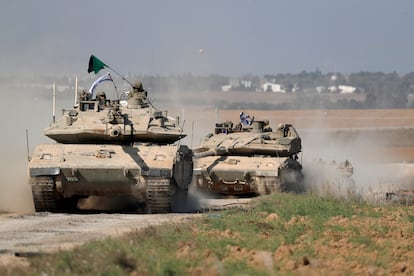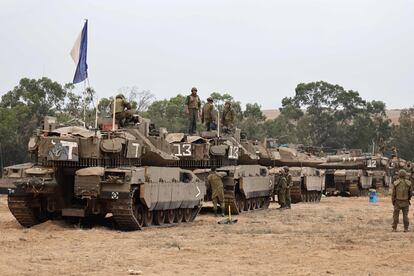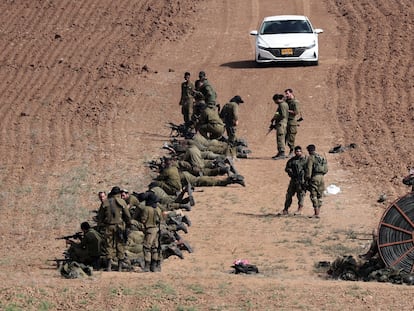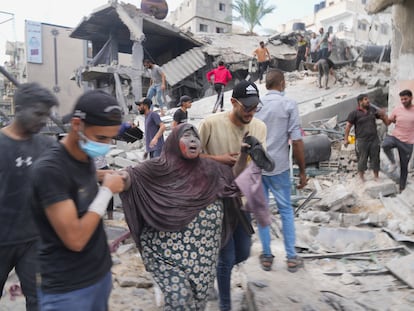The Merkava IV tank, Israel’s main asset for the ground offensive in Gaza
These armored vehicles, which incorporate advanced cameras and artificial intelligence, constitute one of the great Israeli strengths for the urban combat with Hamas that is anticipated in the Strip

The Israeli army is awaiting an order from Benjamin Netanyahu’s government to launch a ground offensive against the Gaza strip. The first phase of the plan to overthrow Hamas, according to Israeli Defense Minister Yoav Gallant, began on October 7 with a “military campaign, including aerial bombardment,” which the enclave has been subjected to for the past two weeks, and which has already claimed more than 5,000 lives. For the next stage, an invasion, troops are deploying military technology on the border. Drones, surveillance devices, and especially tanks, will be key materiel for the operation, which has been delayed after initial expectations of a swift response to the October 7 Hamas attack on Israel.
Once the Israel Defense Forces (IDF) receive the order to advance, they will be able to deploy one of the greatest assets of any army in the world: Merkava IV tanks and the latest variant, the Mark V Barak, which was introduced this year. Their advantages are based on innovation: the tanks are produced and assembled almost entirely in Israel, with the exception of some American, German, and Belgian parts. These armored assault vehicles incorporate advanced cameras and sensors to detect possible threats; they also have a mission computer that uses artificial intelligence and a system called Trophy that serves as a shield against missile attacks. The IDF claims that these vehicles “would force any other tank to its knees.” According to the International Institute for Strategic Studies (IISS), Israel’s Armored Corps has over 2,200 tanks at its disposal, although the Merkava IVs make up only one-fifth of its total strength.
Omar Dostri, a national security expert at the Jerusalem Institute for Strategy and Security, says via email that these modern vehicles are crucial for “destroying targets that have not been eliminated during airstrikes.” In addition, he notes, they will form part of the ground incursion into Gaza to provide “greater security against missile launches.” One of its main assets, the expert underlines, is “its protection system is particularly beneficial in urban combat scenarios.”
Despite having one of the most powerful militaries in the region, the battle Israel intends to wage is one of very complex characteristics. Hamas, which has controlled Gaza since 2007, is acting as a defensive force with local knowledge: Israeli troops have not entered the Strip since 2014. In nearly a decade, experts believe, the militia has improved its attack tactics and increased the number of places where they can hide. “Hamas can set traps and ambush IDF ground forces, as well as mine roads with explosives or resort to snipers in the narrowest streets where these vehicles will pass,” Dostri explains.
Gian Gentile, a retired U.S. colonel and researcher at the RAND analysis center, agrees that ground combat will be fought hand-to-hand. “Hamas will probably fight in small guerrilla-style teams of two or three, so they can hide easily and set improvised traps,” he explains by telephone. According to IISS estimates published in 2022, the Izz ad-Din al-Qassam Brigades, Hamas’ armed wing, numbered between 15,000 and 20,000 militiamen. Regarding the Merkava IVs, Gentile states that “they are simple to drive. With two weeks of training, any military man could do it.” The real challenge lies in maneuvering: in addition to the mountains of rubble left by the air strikes, there are the obstacles that Hamas can construct, leading the expert to note the need for additional support from the outside.

A multidimensional operation
Another difficulty facing the Israeli army is the underground tunnel system, known as the “Gaza metro,” which is controlled by Hamas. The network, which the militia claims stretches 500 kilometers (310 miles) beneath the Strip’s tiny territory, functions as a shelter, command post and a way of mobilizing militia undetected by Israel’s surveillance systems. “There are devices that monitor heat or noise, but the complex geology of the area and the infrastructure built on top [of the network] makes it difficult to target accurately,” Scott Savitz, an engineer and senior analyst at the RAND center, says via video call.
The tanks will be used, according to Gentile, to destroy the entrances and exits to these tunnels. However, access points are often built under buildings used by civilians. UNRWA, the UN agency for Palestinian refugees, reported last year that one of these tunnels passed under one of its schools, a fact it described as a breach of international law. Operation Protective Edge, a two-month military operation launched by Israel in 2014, had the objective of disabling this Gaza metro. However, according to Hamas, the extent of the destruction was minimal.
Will the tanks be sufficient for the offensive? Experts believe that, despite their overwhelming attacking power and security systems, the Israeli army must engage in a “multidimensional operation” if it is to achieve its goal. “Along with tanks, infantry and special forces must be supported by artillery, in addition to air and naval strikes,” says Dostri. A similar opinion is held by Gentile: “Infantry support is needed to keep Hamas militiamen away from the rear of the tanks.”
Once the attack on the “Hamas infrastructure” inside the Strip has been completed, the Israeli army, Gallant said Friday, will begin the second phase, called “system stabilization.” This stage will include attacks of “less intensity, with the aim of eliminating the strongholds of resistance,” that is to say, troops will remain in Gaza to wipe out the insurgent groups, according to the Israeli army.
Sign up for our weekly newsletter to get more English-language news coverage from EL PAÍS USA Edition
Tu suscripción se está usando en otro dispositivo
¿Quieres añadir otro usuario a tu suscripción?
Si continúas leyendo en este dispositivo, no se podrá leer en el otro.
FlechaTu suscripción se está usando en otro dispositivo y solo puedes acceder a EL PAÍS desde un dispositivo a la vez.
Si quieres compartir tu cuenta, cambia tu suscripción a la modalidad Premium, así podrás añadir otro usuario. Cada uno accederá con su propia cuenta de email, lo que os permitirá personalizar vuestra experiencia en EL PAÍS.
¿Tienes una suscripción de empresa? Accede aquí para contratar más cuentas.
En el caso de no saber quién está usando tu cuenta, te recomendamos cambiar tu contraseña aquí.
Si decides continuar compartiendo tu cuenta, este mensaje se mostrará en tu dispositivo y en el de la otra persona que está usando tu cuenta de forma indefinida, afectando a tu experiencia de lectura. Puedes consultar aquí los términos y condiciones de la suscripción digital.
More information
Archived In
Últimas noticias
Christmas Eve for Christians in Gaza: Confinement, no toys, and explosions near the church
AfD, a key pawn for Trump in Europe, strengthens ties with Washington
From cook to sniper: Ukrainian women fight for equality in the army
Trump succeeds in increasing deportations by hiring military personnel to act as judges
Most viewed
- Christian Louboutin: ‘Young people don’t want to be like their parents. And if their parents wear sneakers, they’re going to look for something else’
- Cartels in Mexico take a leap forward with narco-drones: ‘It is criminal groups that are leading the innovation race’
- ‘El Limones’ and the growing union disguise of Mexican organized crime
- Liset Menéndez de la Prida, neuroscientist: ‘It’s not normal to constantly seek pleasure; it’s important to be bored, to be calm’
- The low-cost creative revolution: How technology is making art accessible to everyone










































